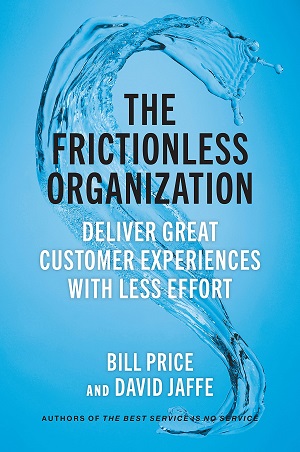
Bill Price and David Jaffe are just, for lack of a better word, fun. In their new book, aptly titled The Frictionless Organization: Deliver Great Customer Experiences with Less Effort, they write all about how to maintain a fluid, postmodernist corporate enterprise. Fluid seems to be the operative word here, other than solid. Indeed, as times change, people change as well. There’s a sense fluidity and a sense of calculated amorphousness, mixed with maintaining timeless tradition, is the name of the game. Specifically, that is, when it comes to maintaining business longevity. In many ways, each of the book’s chapters is a breakdown of several, different concepts and processes Price and Jaffe swear by.
This kind of fact-based zealousness is reflected in passages like the following. “(A) final strategic action is Leverage, and (how) it addresses reasons that are valuable to the customer and valuable for the organization. By definition, every organization wants more (Leverage) contacts, should invest time in them, and may want to increase their frequency. Customers don’t see these contacts as friction (inciting) because they value them, and the organization knows that these interactions are often key to revenue, retention, and relationship-building with the customer,” Price and Jaffe state. “…Analyzing contact reasons, channels, customers, and impacts is a complex process, and it might lead some organizations to leverage a combination that other organizations decide to digitize.
AMAZON: www.amazon.com/Frictionless-Organization-Deliver-Customer-Experiences-ebook/dp/B09LRGZMPZ
Different markets or regions might assign different strategic actions to the same combination based on maturity levels, the trade-off between revenues and costs, and the available staff. It is not easy to separate particular groups of customers or to divert certain reasons to certain channels, leading organizations to apply one-size-fits-all solutions, such as sending all customers to a save team, even though they would prefer to apply that treatment only to the most profitable customers. They might not want to retain the bottom 20% of customers at all, but their processes and systems don’t enable rapid differentiation.”
What could be a dry, entirely statistical read is translated into something that retains its core identity, while having a sense of pace and entertainment value. The quotes, the occasional dialogue, along with the data makes for something that is genuinely compelling for the informed reader. As someone who isn’t necessarily initiated personally with the topicality of the book, I still found it immensely compelling. Particularly because there’s something so inspirational, in terms of tonality, especially at the end of the read. “So how do you get started?” Price and Jaffe write. “First off, consider that you might not have to perform all of the actions defined in the prior chapters…Even so, it’s still valuable to start with the Understand action because too often there is a surprising amount of friction that isn’t well known and shared across the organization.
That may seem an audacious claim, but keep in mind that many organizations have built cultures that hide problems and issues…The Understand action will address these kinds of issues by helping to build a common level of insight around what needs to change, creating momentum that can drive the remaining steps toward becoming frictionless. Similarly, a wholehearted focus on any one of the five strategic actions (Eliminate, Digitize, Leverage, Preempt, and Streamline) will add to the momentum.”
Clay Burton
